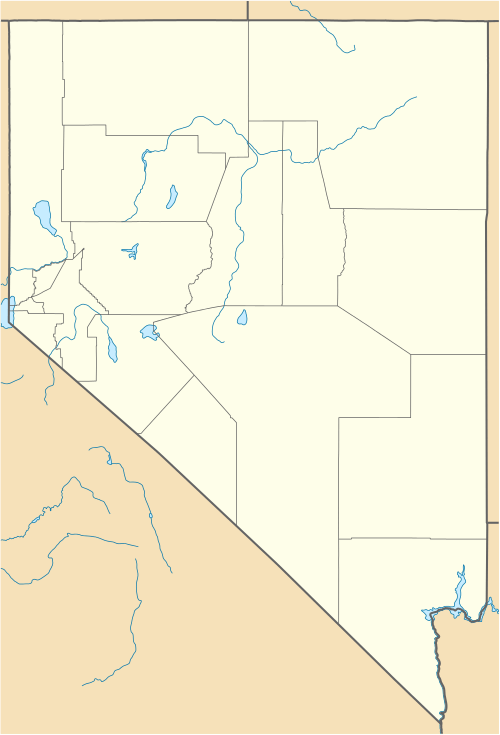Humboldt Cave
|
Humboldt Cave | |
  | |
| Nearest city | Lovelock, Nevada |
|---|---|
| Coordinates | 39°52′54″N 118°43′20″W / 39.88167°N 118.72222°WCoordinates: 39°52′54″N 118°43′20″W / 39.88167°N 118.72222°W |
| Area | 40 acres (16 ha) |
| NRHP Reference # | 76001140[1] |
| Added to NRHP | March 15, 1976 |
Humboldt Cave is an archeological site in Churchill County, Nevada, USA that is one of the earliest documented human habitations in North America. It was inhabited by people of the eponymous Humboldt Culture and the Lovelock Culture, and its documented habitation extends to 9000 BC.
Description
Humboldt Cave is a dry cave which was first excavated by archeologists in 1936. The cave's environment preserved artifacts including fiber and skin garments, bags and mats. Other artifacts found in the cave have documented contact with cultures in what are now Arizona and California. The cave was formed by vertical faulting in a cliff face, which was periodically flooded by Lake Lahontan. The flooding deposited tufa over the cave's surfaces, preserving them from erosion. The remains of the lake, now known as Humboldt Sink, are 220 feet (67 m) below the cave, 6 miles (9.7 km) away. The cave opening is about 8 feet (2.4 m) high and 6 feet (1.8 m) wide, widening to 8 feet (2.4 m) inside, with a depth of about 49 feet (15 m). In addition to humans, the cave was also inhabited by bats, whose guano was 3 feet (0.91 m) to 6 feet (1.8 m) in depth on the cave's floor before excavation.[2]
Excavation
Humboldt Cave was excavated in 1936 by Robert F. Heizer of the University of California, Berkeley. The Archaeology of Humboldt Cave, Churchill County, Nevada was not published until 1956. Heizer concluded that the remote location relative to the lake and marshes made Humboldt Cave a temporary refuge rather than a permanent residence.[3]
Initial stages of excavation concentrated on improving access by widening the cave's opening. The cave was surveyed and divide into twelve sections 3 feet (0.91 m) wide by the width of the cave for individual excavation. Sections were excavated in 6-inch (15 cm) increments.[4] Apart from fur, feather, bone, wood and horn that had been damaged by insects and rodents, artifacts were recovered in near-perfect condition.[5] A total of about 1,400 cubic feet (40 m3) of deposits were removed from the cave. No significant evidence of distinct occupation levels was apparent. Heizer proposed that Humboldt Cave's occupants corresponded to those of the later or upper levels of Lovelock Cave. The cave had been occupied by pack rats, who filled any available space with gathered material, which included artifacts, particularly in a low hollowed space that the excavators called the "South Alcove." Pack rats jumbled much of the material, as was illustrated when, during excavation, a wool sweater was left in the cave. Rats shredded the sweater and took the pieces into the alcove, where parts of sweater were recovered all the way to the solid cave floor during later excavation.[6]
Artifacts
The most significant artifacts recovered during the excavation were usually found in one of 31 cache pits dug into the cave floor by the inhabitants. The pits were lined with worn-out baskets, pieces of baskets, or grass. Cache 13 in particular, called by excavators the "shaman's cache," yielded a birdskin robe, pouches, waterfowl bones and skins, hawk feathers and a stuffed canvasback duck head. The robe was believed to have originally been feathered, the feathers having been extensively damaged by insects while buried. Heizer speculated that the cache's contents might have been curative tokens, or could simply have been used to make decoys.[7] A number of shaped sickles fashioned from bighorn sheep horns were also recovered.[8]
Humboldt Cave was placed on the National Register of Historic Places on March 16, 1976.[1] It was included due to its significance as a prehistoric archaeological site and for its importance as a training ground for students of archaeology.[9]
References
- 1 2 National Park Service (2010-07-09). "National Register Information System". National Register of Historic Places. National Park Service.
- ↑ Mertens, Roger L. (October 9, 1973). "National Register of Historic Places Inventory - Nomination Form: Humboldt Cave" (PDF). National Park Service. Retrieved 2 August 2012.
- ↑ Heizer, Robert F.; Kreiger (1956). "The Archaeology of Humboldt Cave, Churchill County, Nevada" (PDF). University of California Publications in American Archaeology and Ethnology. 47 (1). Retrieved 2 August 2012.
- ↑ Heizer, Kreiger, p. 7
- ↑ Heizer, Kreiger, p. 9
- ↑ Heizer, Kreiger, p. 10
- ↑ Heizer, Kreiger, pp. 11, 12
- ↑ Heizer, Kreiger, p. 15
- ↑ McBride, Terri. "Archaeological Research in Nevada" (PDF). Nevada State Historic Preservation Office. pp. 4, 5. Retrieved 10 August 2012.